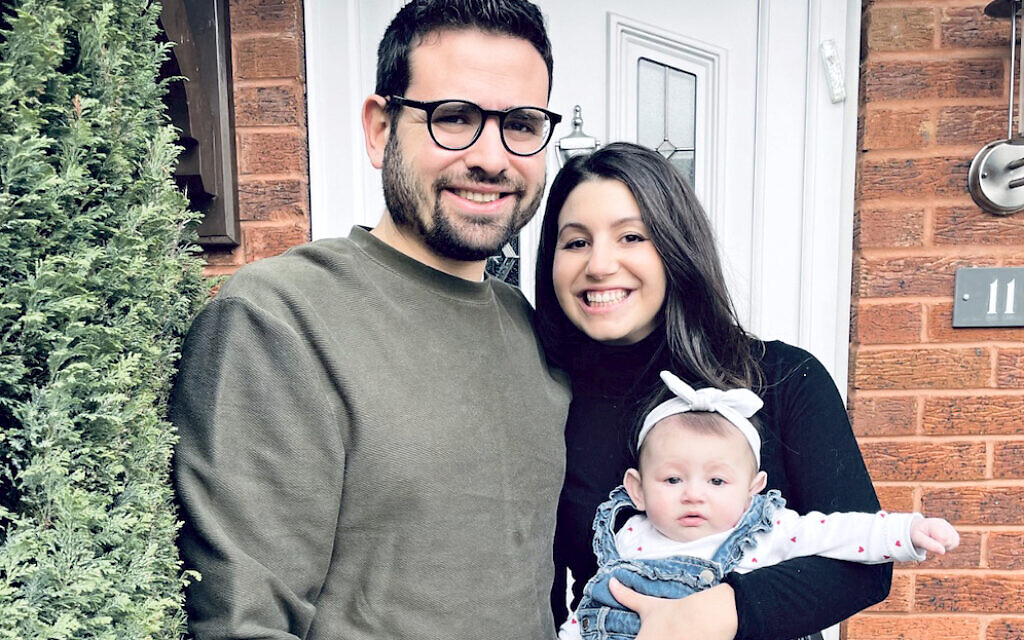‘Screening for genetic disorders gave us peace of mind’
A young couple's discovery that the Canavan’s gene ran in both their families was a heart-in-the-mouth moment
Now aged 28, Gemma first met her husband Craig nine years ago at university in Leeds, when thoughts of starting a family were far from their minds. It was only after they got married in 2018 that they were screened for Jewish genetic disorders.
“I still hear it from friends who say ‘it’s OK, my husband’s Sephardi’, but it only takes one family member to pass the genes down – as we found out,” says Gemma.
Speaking publicly for the first time, the couple say they too “thought we were fine”, until Craig’s parents discovered that the Canavan’s gene, which leads to the rare and progressive neurological Jewish genetic disorder (JGD), ran in their family.
Get The Jewish News Daily Edition by email and never miss our top stories Free Sign Up
“It was a shock to me,” says Craig. “My parents were proactive and thought they’d get tested so we could have the all-clear and relax.”
It was a big moment, the significance of which was lost on no-one, because of a family tragedy on Gemma’s side years earlier.
“I always knew I might be a carrier of Canavan’s disease, which is more common in Ashkenazi Jews, because both my parents are carriers,” says Gemma. “It means there’s a high chance of the children being affected or being carriers.”
Indeed, Gemma’ older sister Madeleine Curtis was affected by the disorder, discovered after she missed a series of developmental milestones. “It was clear something was seriously wrong at an early stage,” says Gemma. Madeleine devastatingly passed away in February 1997 at the age of nine.

Madeleine was born in the 1980’s, when research into JGDs was still in its infancy and tests were only available for a few diseases, such as Tay-Sachs. Very little was known at the time about Canavan’s disease.
After the discovery, Gemma says “a big question mark hung over my parents’ heads about having more children”.
IVF was not an option because it was not a fertility issue. “They were told they could have more children naturally, but in doing so they ran a 25 percent risk of having another disabled child.
“Fortunately, they had two more healthy children – my younger sister and I – but not without huge sacrifice and anxiety, all of which could have been avoided if reliable research and testing had been available.”
This meant that the discovery that Craig’s family carried the gene was a heart-in-the-mouth moment. The chances of the couple both being carriers shrank from one in 13,500, to one in two, with a one in four chance of their children being affected.
“We were in shock,” says Craig. “We felt sick to the stomach, but we were on the same page in terms of what to do.” Gemma nods.
“Two people being the carrier of the same gene is very rare,” says Gemma. “Carrying the same recessive gene as her partner’s parents is really uncommon. But not as uncommon as we thought!”
We felt sick to the stomach, but we were on the same page in terms of what to do
The couple were told about Jnetics, set about getting screened, and ultimately avoided the anguish Gemma’s parents suffered, but were “on shpilkes” before then.
“After ten long weeks of waiting, on our wedding anniversary in fact, we found out that Craig was not a carrier,” says Gemma. “Although I am, and although our children may be, it meant that our chances of having an affected child were extremely low. It gave us the peace of mind that others sadly don’t have.”
Did they actually discuss ‘what if’ during the wait? “We did,” says Craig. “We decided that we would go down the IVF route.” Gemma is in full agreement. “I couldn’t do what my parents did and risk it,” she says.
“It’s heart-wrenching. They were very, very lucky – neither my sister nor I were affected. Had we been, they’d have had to make a horrible decision about what to do. I just don’t think I could do that.”
Although I am, and although our children may be, it meant that our chances of having an affected child were extremely low. It gave us the peace of mind that others sadly don’t have
Thankfully, that was not necessary. Last year, the couple had a beautiful, healthy baby daughter they called Mia, named after Madeleine. “We’re two of the lucky ones,” they say.
“We have friends who say they’re not going to get tested. We do everything we possibly can to convince them that it’s worth it.”
They say they now hope young Jewish couples hearing their story “realise how important it is to get tested, even if you think there is little to no chance that you can be affected, because you might be a carrier without even knowing”.
For more information visit www.jnetics.org

Thank you for helping to make Jewish News the leading source of news and opinion for the UK Jewish community. Today we're asking for your invaluable help to continue putting our community first in everything we do.
For as little as £5 a month you can help sustain the vital work we do in celebrating and standing up for Jewish life in Britain.
Jewish News holds our community together and keeps us connected. Like a synagogue, it’s where people turn to feel part of something bigger. It also proudly shows the rest of Britain the vibrancy and rich culture of modern Jewish life.
You can make a quick and easy one-off or monthly contribution of £5, £10, £20 or any other sum you’re comfortable with.
100% of your donation will help us continue celebrating our community, in all its dynamic diversity...
Engaging
Being a community platform means so much more than producing a newspaper and website. One of our proudest roles is media partnering with our invaluable charities to amplify the outstanding work they do to help us all.
Celebrating
There’s no shortage of oys in the world but Jewish News takes every opportunity to celebrate the joys too, through projects like Night of Heroes, 40 Under 40 and other compelling countdowns that make the community kvell with pride.
Pioneering
In the first collaboration between media outlets from different faiths, Jewish News worked with British Muslim TV and Church Times to produce a list of young activists leading the way on interfaith understanding.
Campaigning
Royal Mail issued a stamp honouring Holocaust hero Sir Nicholas Winton after a Jewish News campaign attracted more than 100,000 backers. Jewish Newsalso produces special editions of the paper highlighting pressing issues including mental health and Holocaust remembrance.
Easy access
In an age when news is readily accessible, Jewish News provides high-quality content free online and offline, removing any financial barriers to connecting people.
Voice of our community to wider society
The Jewish News team regularly appears on TV, radio and on the pages of the national press to comment on stories about the Jewish community. Easy access to the paper on the streets of London also means Jewish News provides an invaluable window into the community for the country at large.
We hope you agree all this is worth preserving.
-
By Brigit Grant
-
By Laurent Vaughan - Senior Associate (Bishop & Sewell Solicitors)
-
By Laurent Vaughan - Senior Associate (Bishop & Sewell Solicitors)
-
By Laurent Vaughan - Senior Associate (Bishop & Sewell Solicitors)
-
By Laurent Vaughan - Senior Associate (Bishop & Sewell Solicitors)






















